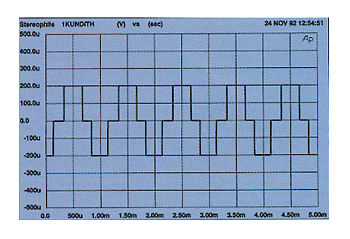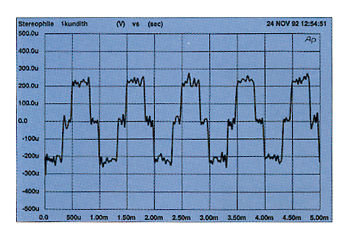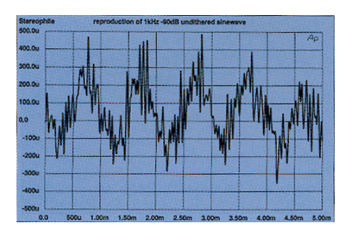| Columns Retired Columns & Blogs |
Can one correlate intersample overs to the square wave phenomenon JA is referring to here? That is, Philips, Wadia, Pioneer's Legato Linear, and Meitner do not "compress" the overs?

Fig.8 Perfect waveform of undithered, 16-bit, 1kHz sinewave at -90.31dBFS with no bandwidth restriction.

Fig.9 Excellent CD player, waveform of undithered, 16-bit, 1kHz sinewave at -90.31dBFS. The "ringing" at the bit transitions is almost entirely due to the CD system's restricted bandwidth.

Fig.10 Poor CD player, waveform of undithered, 16-bit, 1kHz sinewave at -90.31dBFS. The bit transitions are smothered by audioband noise.
Noise modulation
Testing a DAC's noise modulation was suggested by an Audio Engineering Society paper given by Dr. Richard Cabot, Principal Engineer at Audio Precision (footnote 5). The measurement looks at how a digital processor's noise floor shifts (modulates) with changing input level. Not only does the noise floor change in level, but the noise floor's spectral balance can be very different at different input levels. Research by Louis Fielder at Dolby Laboratories (those guys know something about noise modulation!) suggests that spectral shifts as small as 2dB are audible.
In the noise-modulation test, the processor is driven by the code representing a 41Hz sinewave at -60dBFS. The low-frequency test signal exercises the DAC, and the resulting noise after the processor's output has been high-pass-filtered to remove the test signal is plotted against frequency. The test is repeated at four additional levels (-70dB, -80dB, -90dB, -100dB), and the plots are combined on a single graph. This makes comparing noise-floor levels and spectral balance between input levels easier.

Can one correlate intersample overs to the square wave phenomenon JA is referring to here? That is, Philips, Wadia, Pioneer's Legato Linear, and Meitner do not "compress" the overs?